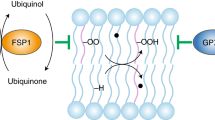Summary
When calcinine (A-23187) (2 μM), a known Ca2+ ionophore, is present, a significant protection is observed to a mitochondrial suspension undergoing lipid peroxidation by Fe2+-citrate complex. A-23187 can remove Ca2+, which seems to have an important role in the lipid peroxidation process, from its ‘lesive sites’ and consequently preventing the damage. This information has importance in terms of knowing the mechanisms and avoiding the damages of lipid peroxidation that occur in some pathological cases such as tumor promotion and hemochromatosis.
Similar content being viewed by others
Abbreviations
- EGTA:
-
ethyleneglycolbis (β-amino-ethyl ether) N,N’-tetraacetic acid
- TPP:
-
tetraphenylphosphonium
- HEPES:
-
4-(2-hydroxyethyl)-1-piperazineethanesulfonic acid
- RLM:
-
rat liver mitochondria; and ΔΨ transmembrane electrical potential
References
Slater T.F. (1972): Free Radical Mechanisms in Tissue Injury. London, Pion Limited.
Pryor W.A. (1978): The formation of free radicals and the consequences of their reactions in vivo. Photochem. Photobiol., 28, 787–801.
Halliwell B., Gutteridge J.M.C. (1984): Oxygen toxicity oxygen radicals, transition metals and disease. Biochem. J., 219, 1–14.
Gutteridge J.M.C. (1991): Hydroxyl radical formation from the autoreduction of a ferric citrate complex. Free Rad. Biol. Med., 11, 401–406.
Baker M.S., Gebicki J.M. (1986): The effect of pH on yields of hydroxyl radicals produced from superoxide by potential biological iron chelators. Arch. Biochem. Biophys., 246, 581–588.
Crosby W.H. (1987): Hemochromatosis: current concepts and management. Hosp. Pract., 22, 17–21.
Cerutti P.A. (1985): Prooxidant states and tumor promotion. Science, 227, 373–381.
Wolkowicz P.E., McMillin-Wood J. (1980): Dissociation between mitochondrial calcium ion release and pyridine nucleotide oxidation. J. Biol. Chem., 255, 10348–10353.
Debono M., Molloy R.M., Dorman D.E., et al. (1981): Synthesis and characterization of halogenated derivatives of the ionophore A-23187: enhanced calcium ions transport specificity by the 4-bromo derivative. Biochemistry, 20, 6865–6872.
Kamo N., Muratsugo M., Ruji H., Kobatake J. (1979): Membrane potential of mitochondria measured with an electrode sensitive to tetraphenylphosphonium and relationship between proton electrochemical potential and phosphorylation potential in steady-state. J. Membr. Biol., 48, 105–121.
Muratsugu M., Kamo K., Kurihara K., Kobatake J. (1977): Selective electrode for dibenzyl ammonium cation as indicator of membrane potential in biological systems. Biochim. Biophys. Acta, 464, 613–619.
Jelisen B.D., Gunter K.K., Gunter T.E. (1986): The efficiencies of the component steps of oxidative phosphorylation. II. Experimental determination of the efficiencies in mitochondria and examination of the equivalence of membrane potential and pH gradient in phosphorylation. Arch. Biochem. Biophys., 248, 305–323.
Bindoli A., Cavallini L., Siliprandi N. (1977): Effect of thiol oxidation on lipid peroxidation in rat liver mitochondria. Chem. Biol. Interact., 19, 383–386.
Pereira R.S., Bertocchi A.P.F., Vercesi A.E. (1992): Protective effect of trifluoperazine on the mitochondrial damage induced by Ca2+ plus prooxidants. Biochem. Pharmacol., 44, 1795–1801.
Kosower N.S., Kosower E.M. (1978): The glutathione status of cells. Int. Rev. Cytol., 54, 109–160.
Fagian M.M., Pereira-da-Silva L., Martins I.S., Vercesi A.E. (1990): Membrane protein thiol cross-linking associated with the permeabilization of the inner mitochondrial membrane by Ca2+ plus prooxidants. J. Biol. Chem., 265, 19955–19960.
Nagarkatti M., Nagarkatti P.S. (1989): Calcium ionophores at concentrations mitogenic to normal murine T cells inhibit the proliferation of tumor cells in vitro. Cancer Commun., 1, 329–334.
Author information
Authors and Affiliations
Rights and permissions
About this article
Cite this article
Pereira, R.S. Lipid peroxidation: the role of Ca2+ and protection by calcinine. European Journal of Drug Metabolism and Pharmacokinetics 21, 23–26 (1996). https://doi.org/10.1007/BF03190274
Received:
Issue Date:
DOI: https://doi.org/10.1007/BF03190274




